When planning freezer meals for your sun oven, you'll find the most success with coconut lime chicken, Hawaiian chicken bowls, and hearty soups that retain their flavors well. Casseroles and baked dishes like beef ravioli reheat evenly, while hand pies maintain their structure during warming. For best results, use dark, shallow containers and wrap meals tightly in plastic and foil. You'll need to allow 1.5-2 hours for proper reheating, and covering containers with tin foil and a tea towel improves insulation. These tried-and-true options are just the beginning of your solar cooking journey.
Best Freezer Meals for Sunlight
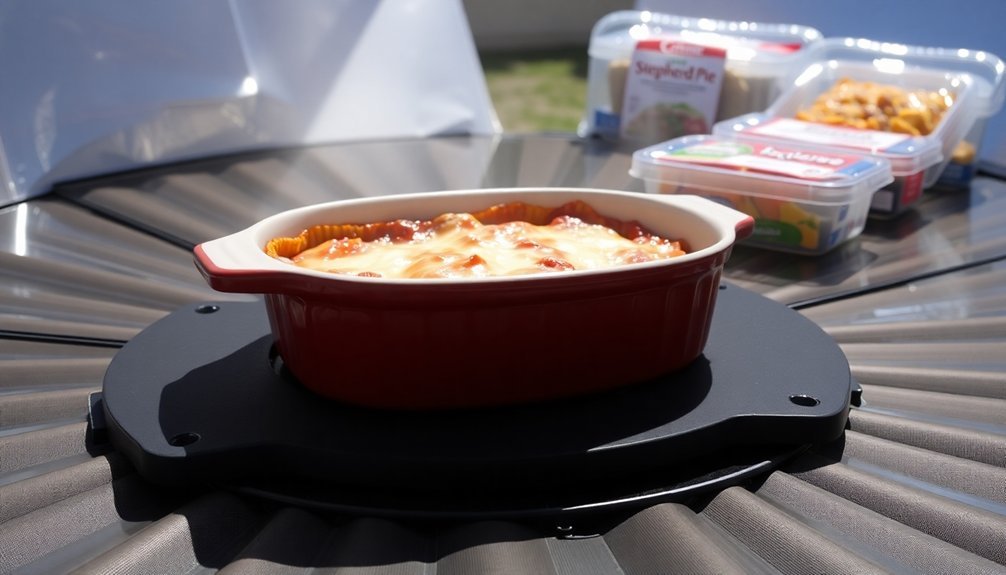
The versatility of sun oven cooking makes it perfect for preparing freezer meals that you can easily reheat using natural sunlight.
You'll find that dishes like Coconut Lime Chicken and Hawaiian Chicken Bowls work exceptionally well, as they maintain their flavors and textures during the freezing and reheating process. These meals are especially convenient for busy weeknight dinners.
For best results, consider soups and casseroles, which heat evenly in sun ovens.
Lemon Chicken White Bean Soup and Baked Beef Ravioli are excellent choices that reheat quickly.
If you're using a slow cooker adapter, try Buffalo Chicken Wraps or Caesar Pork Chops and Potatoes.
These meals require minimal effort – just thaw and heat.
You'll also succeed with hand pies and contained dishes like Chicken Pot Pie Hand Pies, which retain their structure while warming through completely.
Essential Solar Cooking Equipment
Successful solar cooking starts with selecting the right equipment for your needs.
You'll want to choose dark-colored, thin-walled pots with tight-fitting glass lids to maximize heat absorption and retention. These vessels work best when paired with silicone rims that can withstand prolonged sun exposure. It's essential to prop the lids open periodically to stir and check on your meals.
For monitoring temperatures and ensuring food safety, you'll need a reliable thermometer.
Don't forget essential safety items like pot holders for handling hot cookware.
If you're using a box-style cooker, gather materials like aluminum foil for reflection, clear plastic wrap or glazing for heat trapping, and dark construction paper for absorption.
Include proper insulation materials such as newspaper or foam to maintain consistent cooking temperatures.
Preparing Meals for Solar Reheating
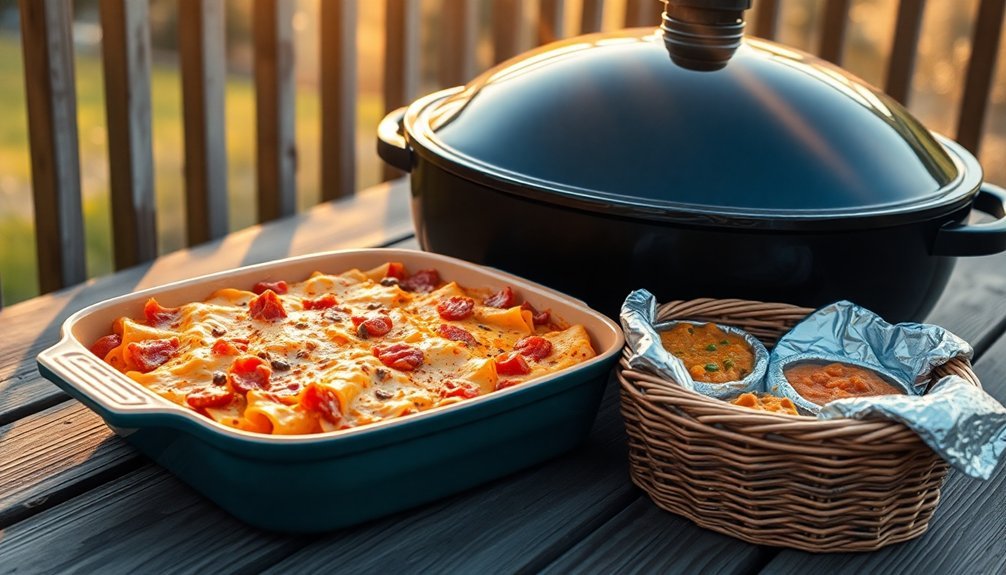
To prepare successful freezer meals for your sun oven, you'll need containers that can safely go from freezer to solar oven while effectively conducting heat.
You'll want to portion your meals in dark, shallow dishes that maximize solar absorption and guarantee thorough reheating throughout the food.
When freezing your prepared dishes, wrap them tightly in plastic and foil, making sure to label each container with reheating instructions specific to solar cooking times and temperatures. Testing frozen meals like the beef ragù rigatoni recipe shows that thorough reheating typically takes 1.5-2 hours in a sun oven.
Proper Container Selection
Selecting appropriate containers plays an essential role in solar oven meal preparation. You'll want to use oven-safe dishes, preferably glass or dark-colored metal ones, that can withstand high temperatures while efficiently absorbing heat. Slow cooking methods allow frozen meals to thaw and heat thoroughly while retaining their flavors.
Cover your containers with tin foil and add a tea towel for better insulation, ensuring the heat stays trapped during the cooking process.
- Choose flat-bottomed containers that fit comfortably in your solar oven and allow for even heat distribution.
- Opt for smaller, shallow dishes when possible, as they'll heat more quickly and uniformly.
- Consider recycling oven-safe containers from store-bought frozen meals to reduce waste.
- Avoid plastic containers unless they're specifically marked as oven-safe to prevent melting or chemical leaching.
Don't forget to grease your container and position it centrally in direct sunlight, rotating every 10-15 minutes for best results.
Safe Freezing Methods
Proper freezing methods guarantee your solar-warmed meals will taste just as good as when you first made them.
Let your cooked dishes cool completely before freezing to prevent ice crystals from forming. Choose foods that freeze well, like stocks, soups without noodles, and casseroles, while avoiding items with high water content.
Package your meals in portion sizes that'll work efficiently in your sun oven. Use airtight containers or freezer bags, removing as much air as possible to prevent freezer burn.
Don't forget to label everything with dates and contents. Store your frozen meals in the coldest part of your freezer, keeping raw ingredients below cooked items to prevent cross-contamination.
When you're ready to reheat, verify your solar oven reaches at least 140°F and heat until the food's internal temperature hits 165°F.
Portioning For Solar Success
Successful solar reheating starts with smart meal portioning that matches your sun oven's capacity. You'll want to divide your freezer meals into 2-4 serving portions that can be heated in a single session. Use black containers with tight-fitting lids to maximize heat absorption and retention. For best results, choose moisture-rich dishes like stews and casseroles that won't dry out during the reheating process.
- Pack meals in oven-safe bags for additional insulation and easier handling
- Label containers with contents and dates to maintain an organized rotation
- Select portion sizes that allow for complete heating within available sunlight hours
- Choose container shapes that fit your solar oven while allowing proper heat distribution
When reheating, remember to preheat your sun oven for 30 minutes and adjust its position every half hour to track the sun's movement.
Temperature Control and Timing Tips
To consistently achieve delicious freezer meals in your sun oven, you'll need to master temperature control and timing techniques. Use a reliable thermometer with Type-K thermocouples to maintain temperatures between 150-225°F, and rely on a meat thermometer rather than a timer to determine doneness.
Position your oven directly facing the sun and adjust it every 30-45 minutes using a Lazy Susan for smooth rotation. You'll want to cook during peak hours (10-4 in summer) and preheat the oven before adding your frozen meals.
On cloudy days, expect cooking times to double. For ideal heat retention, use dark-colored, lidded cookware and verify your oven's insulation is properly layered with materials like crumpled newspaper or spun fiberglass.
Keep the glazing material securely fastened to prevent heat loss.
Storage and Portion Planning
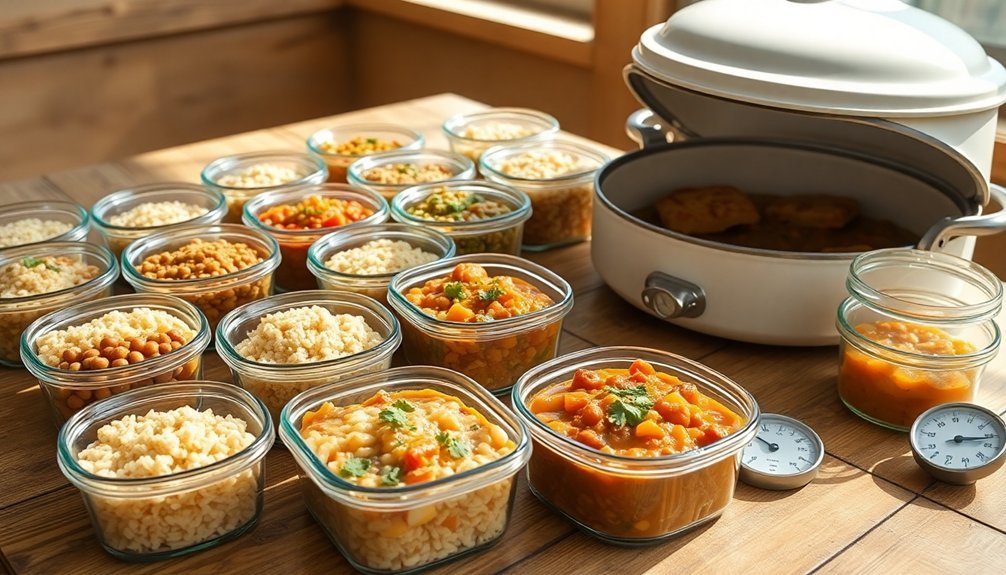
Your success with sun oven freezer meals starts with choosing the right containers, from oven-safe dishes to reusable silicone bags that'll shift smoothly from freezer to sun oven.
You'll want to portion your meals based on your family's needs, typically planning for 2 pounds of food per 4 people and using clear labeling to track contents and dates.
For long-term storage, organize your freezer space efficiently by using a combination of Souper Cubes for initial freezing and transferring to freezer bags for compact storage that maximizes your available space.
Proper Container Selection
Selecting the right containers for freezer meals plays an essential role in maintaining food quality and organizing your Sun Oven meal prep efficiently.
You'll want to choose containers that adapt well from freezer to Sun Oven while keeping your portions manageable. Freezer-safe glass containers work exceptionally well since they're compatible with both storage and cooking methods.
- Use Souper Cubes in 1-cup or 2-cup sizes to create perfectly portioned meals that'll fit neatly into ziplock bags.
- Choose round containers over rectangular ones to promote better airflow and reduce moisture buildup.
- Opt for reusable silicone bags when you need flexible storage that's environmentally friendly.
- Consider aluminum foil containers with adjustable dividers for pre-made meals that require separate compartments.
Remember to label each container with dates and rotate your stock regularly to maintain freshness.
Freezer-to-Oven Portioning Methods
When planning freezer meals for your Sun Oven, proper portioning methods can streamline your meal prep and cooking process.
Line your baking pans with foil or wax paper, then portion and freeze meals directly in these containers. You'll find it easier to remove and rewrap the frozen meals for storage.
Consider using disposable pans, especially if you're sharing meals with others. They're lighter, less expensive, and don't need to be returned.
For liquid-based dishes, try Souper Cubes or similar trays to create perfectly sized portions that you can easily transfer to freezer bags.
Remember to use shallow containers whenever possible, as they'll help your meals freeze and thaw more quickly.
Don't forget to label each portion with contents, cooking instructions, and the date you've frozen them.
Long-Term Storage Solutions
Three key factors determine successful long-term storage of Sun Oven freezer meals: temperature control, proper packaging, and smart portioning.
You'll need to maintain your freezer at -18°C for ideal storage beyond three months, while ensuring your meals are wrapped properly to prevent freezer burn.
When preparing meals for your Sun Oven, portion them thoughtfully in freezer-safe containers, filling them no more than ¾ full to allow for expansion during freezing.
- Use reusable silicone bags or glass containers to minimize environmental impact and maintain food quality
- Label all containers with contents and dates, keeping a master list on your freezer door
- Store meals in single-serving portions to avoid unnecessary thawing
- Organize your freezer with adjustable dividers to easily locate meals when you're ready to use your Sun Oven
Common Solar Cooking Mistakes
Despite the simplicity of solar cooking, many people make avoidable mistakes that can greatly impact their cooking results. You'll get better outcomes by preheating your Sun Oven and removing all protective films from reflectors before use.
Don't forget to align the oven properly with the sun's rays and adjust it throughout the day.
Avoid using aluminum foil to cover food since it reflects sunlight away from your meal. Instead, use non-reflective materials like plastic wrap or baking bags.
Always place cookware on the leveling rack, not directly on the oven floor. Choose dark, heat-absorbing pots and pans for best results.
Remember to keep the oven door closed while cooking to maintain temperature, and always thaw frozen foods completely before placing them in your preheated Sun Oven.
Seasonal Meal Planning Guidelines
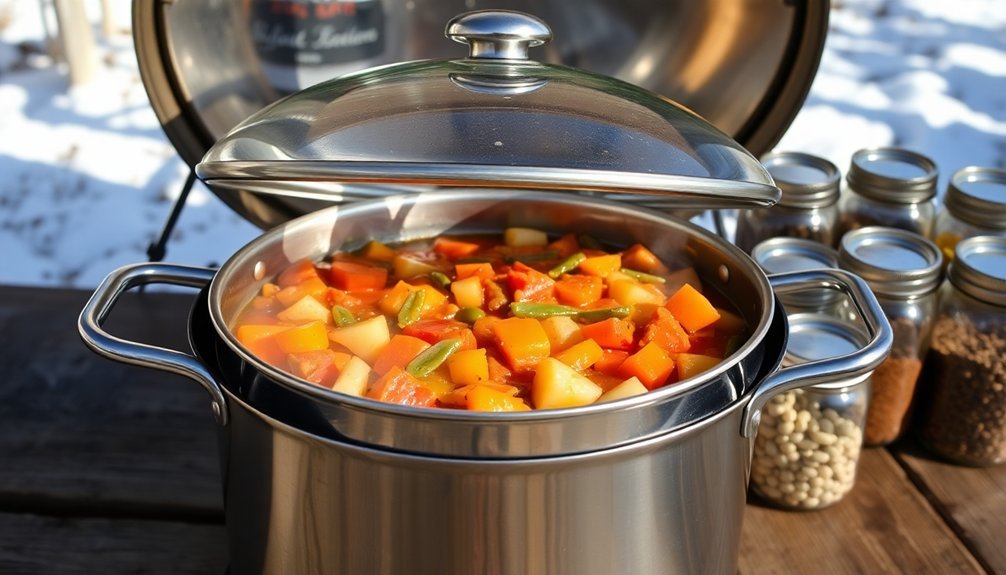
Successful meal planning for your Sun Oven starts with understanding seasonal availability of produce throughout the year.
You'll want to align your freezer meal prep with nature's harvest schedule, incorporating winter's root vegetables, spring's tender greens, summer's juicy produce, and fall's hearty offerings.
By planning at least five seasonal meals weekly, you can maximize both freshness and cost-effectiveness.
- Create a rotating meal schedule that matches local growing seasons, ensuring you're cooking with the freshest ingredients.
- Combine fresh seasonal produce with preserved items from your storage to maintain variety year-round.
- Start small when experimenting with new seasonal recipes in your Sun Oven.
- Keep a seasonal inventory of your frozen meals and stored produce to reduce waste and maintain quality.
Remember to batch cook when specific produce is abundant, ensuring you'll have delicious Sun Oven meals throughout the year.
Frequently Asked Questions
Can Frozen Meals Be Thawed Before Placing in a Sun Oven?
You don't need to thaw frozen meals before using your Sun Oven. The oven will thaw and cook your food simultaneously, though you'll need to allow extra cooking time of about 1.5-2 hours.
How Do Cloudy Days Affect the Reheating of Frozen Meals?
On cloudy days, you'll experience slower reheating times for your frozen meals. You'll need to double your cooking time, monitor temperatures closely, and regularly realign your sun oven to maintain safe heating temperatures.
What Happens if Rain Starts During Sun Oven Cooking?
If rain starts during sun oven cooking, you'll need to move your food inside quickly. Transfer it to a slow cooker or conventional oven, as the lack of sunlight will prevent proper cooking temperatures.
Does Altitude Affect Cooking Times for Frozen Meals in Sun Ovens?
Yes, you'll need longer cooking times at higher altitudes. Your frozen meals will take about 25% more time to cook in a sun oven, and you'll want to monitor them closely with a food thermometer.
Can Glass Containers Be Used Instead of Black Pots?
Yes, you can use glass containers instead of black pots, but they're less efficient. You'll need to extend cooking times and might want to add reflective materials or insulation to improve heat absorption and retention.
In Summary
You'll find solar cooking your freezer meals rewarding once you've mastered the basics. Remember to package portions appropriately, monitor weather conditions, and start early in the day for best results. Keep experimenting with different recipes while adjusting cooking times based on sunlight intensity. By avoiding common pitfalls and planning seasonal meals thoughtfully, you'll soon be confidently preparing delicious solar-reheated freezer meals for your family.

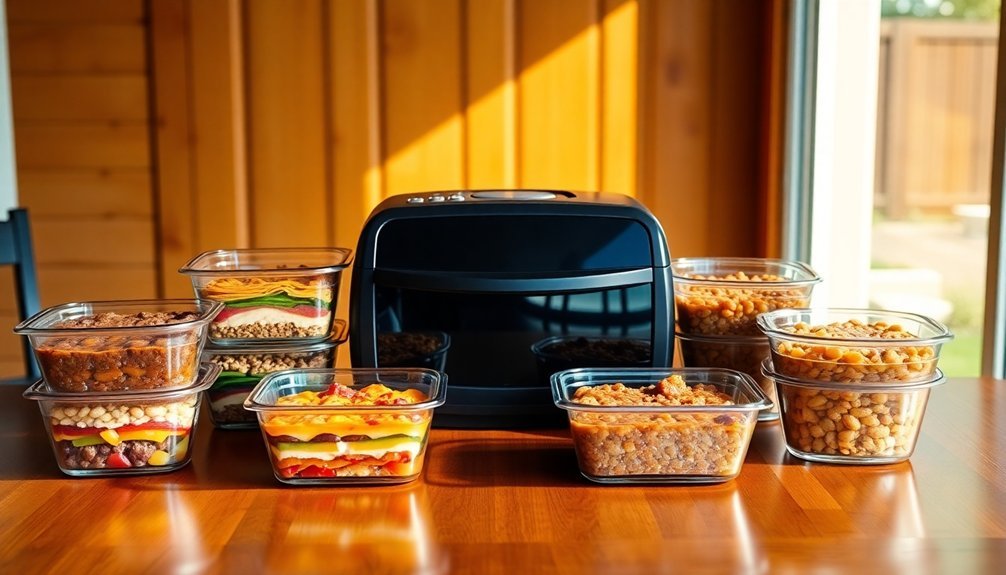
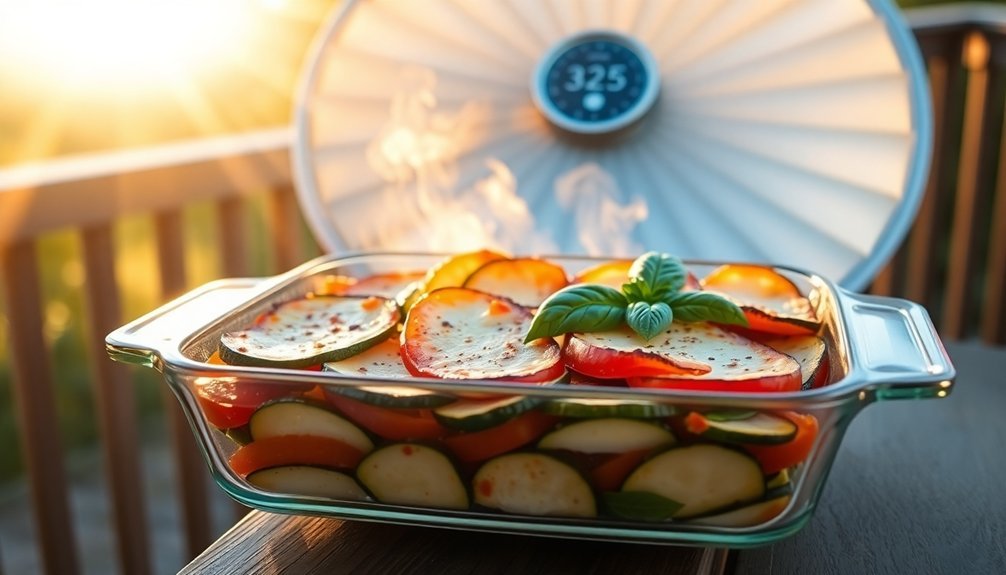

Leave a Reply